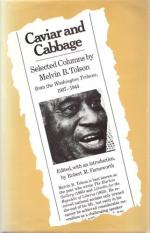|
This section contains 3,270 words (approx. 11 pages at 300 words per page) |

|
SOURCE: "Telling It Like It I-S 'IS': Narrative Techniques in Melvin Tolson's 'Harlem Gallery,'" in New England Review and Bread Loaf Quarterly, Vol. VIII, No. 1, Autumn, 1985, pp. 109-17.
In the following review, Dove traces Tolson's Harlem Gallery and its reception among African-American intellectuals.
When Melvin B. Tolson published part I of his projected epic poem, Harlem Gallery, in 1965, critical response was immediate and controversial. Whereas the mainstream literati (read: white) were enthusiastic, proclaiming Tolson's piece as the lyrical successor of The Waste Land, The Bridge, and Paterson, proponents of the rapidly solidifying Black Aesthetic were less impressed. Part of the controversy was sparked by Karl Shapiro's well-meaning Foreword. "Tolson writes and thinks in Negro," Shapiro pronounced, prompting poet and essayist Sarah Webster Fabio to remark:
Melvin Tolson's language is most certainly not "Negro" to any significant degree. The weight of that vast, bizarre, pseudo-literary diction is to...
|
This section contains 3,270 words (approx. 11 pages at 300 words per page) |

|


